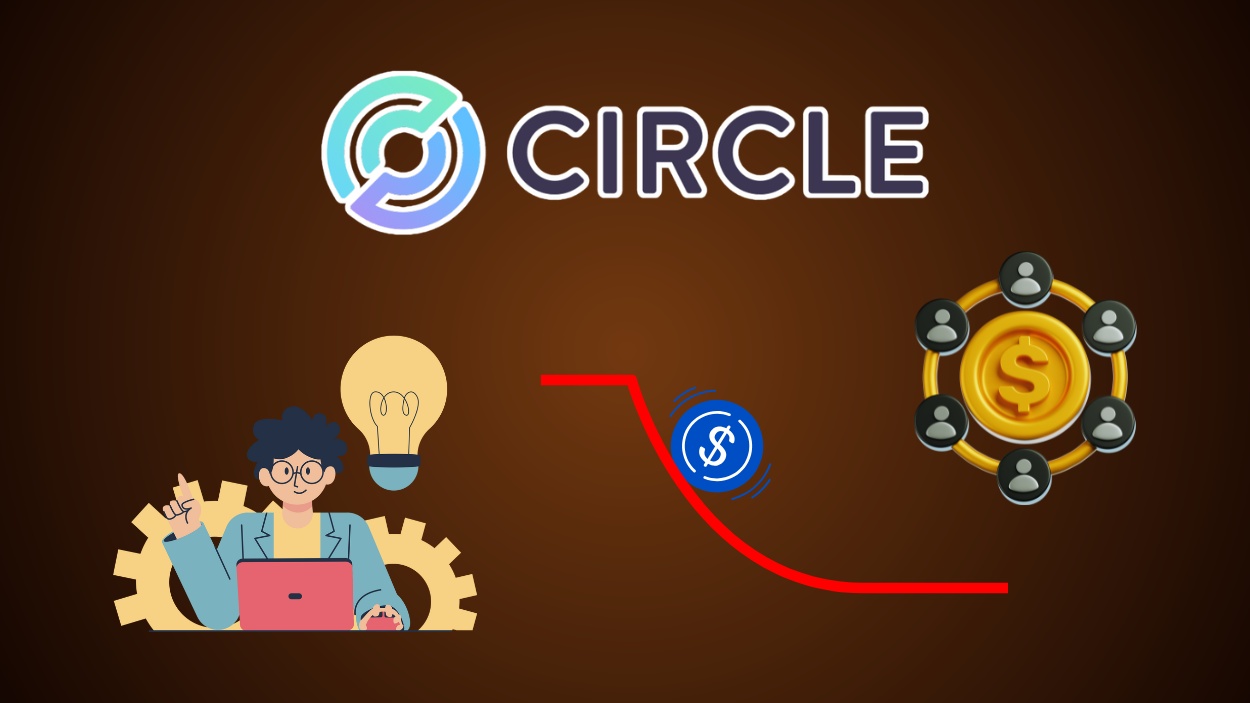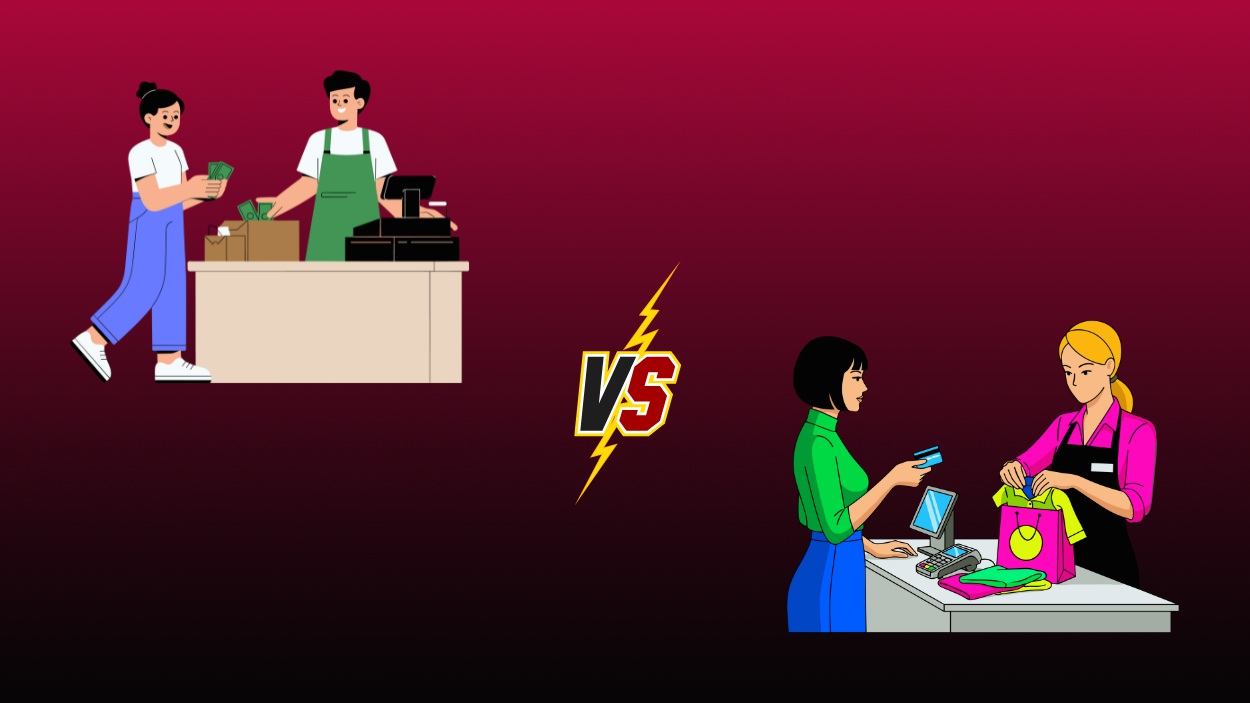In the rapidly evolving world of finance, digital remittance has emerged as a critical tool for millions of people worldwide, connecting families and fueling economies. With technology advancing at an unprecedented pace, the way money is transferred across borders is becoming faster, more secure, and more accessible. Imagine a migrant worker in the US sending money to his family in the Philippines in just seconds, this is the reality of today’s digital remittance landscape. As we look ahead to 2025, this market promises to grow even further, driven by key milestones, technological advancements, and a rising global need for seamless financial solutions.
Editor’s Choice
- The global digital remittance market is projected to reach $29.2 billion in 2025, reflecting a 15% year-over-year growth.
- Mobile-based remittance transactions now account for 60% of all digital remittance transfers in 2025.
- The top three countries receiving the highest remittance inflows in 2025 are India ($125 billion), Mexico ($66.24 billion), and China ($49.5 billion).
- By the end of 2025, 60% of all remittances globally will be processed using fintech platforms, indicating a continued decline in traditional bank transfers.
- Blockchain technology is playing a transformative role. By 2025, 12% of all global remittances are expected to use blockchain-powered systems, enhancing transparency and reducing costs.
- In 2025, the average cost of sending $200 through digital remittance channels has dropped to 4.6%, compared to 7% in 2017, moving closer to the UN’s target of 3%.
- Western Union and MoneyGram remain dominant in the market, but newer players like Remitly and Wise (formerly TransferWise) are gaining considerable market share due to their lower fees and faster transfers.
Regional Breakdown of the Global Digital Remittance Market
- North America leads the global digital remittance market with a 32.0% share, reflecting strong adoption of digital financial services.
- APAC (Asia-Pacific) holds the second-largest market share at 28.9%, driven by high mobile penetration and remittance activity.
- Europe accounts for 26.3% of the global market, showcasing steady growth in cross-border digital transfers.
- South America contributes 9.1% to the global digital remittance market, indicating emerging opportunities in the region.
- MEA (Middle East and Africa) has the smallest share at 3.7%, though it shows potential for growth with expanding fintech infrastructure.
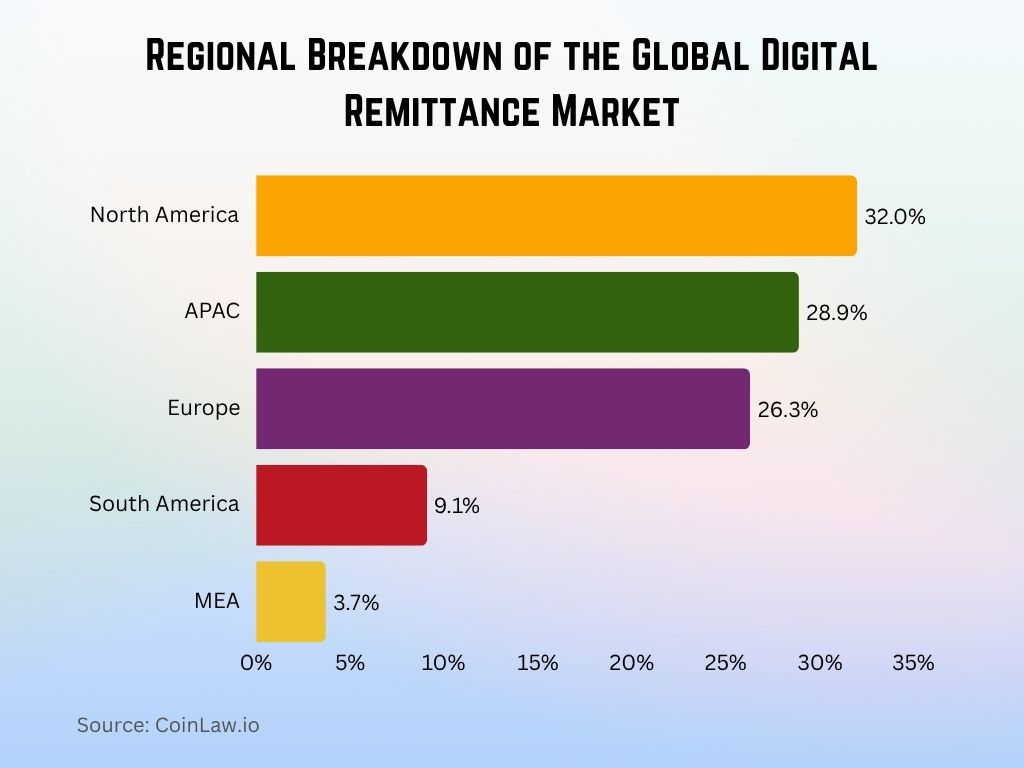
Technological Advancements in Remittances
- AI-powered fraud detection is now utilized by 90% of financial institutions, significantly enhancing real-time threat identification and reducing fraudulent transactions.
- RippleNet has expanded its reach to over 70 countries, enabling cross-border payments to settle in 3–5 seconds, a substantial improvement over traditional methods.
- The adoption of biometric authentication in digital remittances has led to a 22% reduction in unauthorized transactions, bolstering security and user trust.
- API integrations between traditional banks and digital remittance platforms have streamlined cross-border payments, reducing transfer fees by an average of 15% and enhancing transaction speed.
- The smart contracts market is projected to grow from $3.69 billion in 2025 to approximately $815.86 billion by 2034, reflecting their increasing role in automating and securing digital remittance transactions.
- The growth of mobile payment solutions like Apple Pay and Google Pay is transforming remittances, allowing users to send money with just a few taps, contributing to a 45% increase in mobile-based remittance transactions.
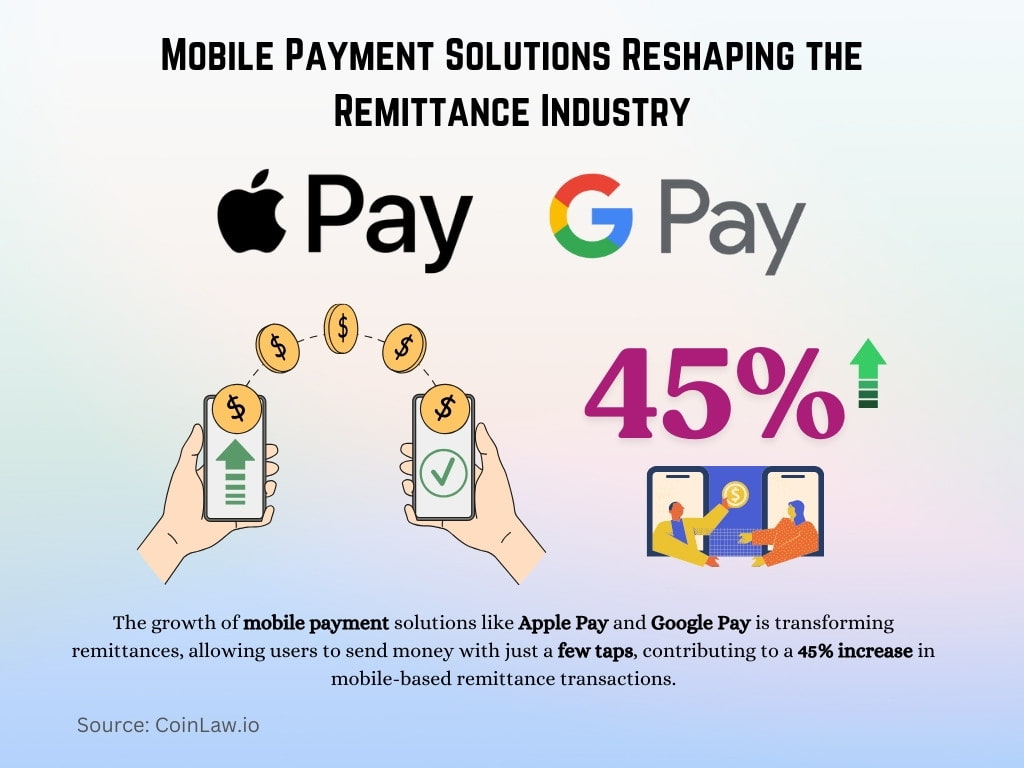
- AI-powered chatbots on remittance platforms are improving customer support, providing instant assistance, and reducing customer query resolution times by 35%.
Regional Insights and Market Trends
- Asia-Pacific accounts for 38% of global remittance inflows in 2025, with India and the Philippines leading the region.
- Sub-Saharan Africa is projected to grow digital remittance volumes by 5.2% in 2025, driven by mobile money services like M-Pesa.
- Latin America and the Caribbean are expected to receive over $158 billion in remittances in 2025, with Mexico and Guatemala as top recipients.
- Eastern Europe, including Ukraine and Poland, continues to benefit from migrant remittances, contributing significantly to regional GDP in 2025.
- North America, led by the United States, contributes over $160 billion in remittance outflows globally in 2025.
- Middle Eastern nations like Saudi Arabia and the UAE send more than $67 billion in remittances in 2025, mainly to South Asia.
- Africa is a hotspot for remittance innovation in 2025, with platforms like Chipper Cash and WorldRemit expanding aggressively in Nigeria, Kenya, and beyond.

Competitive Landscape and Market Dynamics
- Global digital remittance platforms exceeded 500 in 2025, reflecting intensified competition and innovation.
- Wise expands its European market share to 10.2% in 2025, capitalizing on demand for low-cost, transparent cross-border transactions.
- PayPal processes over $1.68 trillion in total payment volume, with continued growth into 2025, focusing on Latin America and Southeast Asia.
- Western Union reports $984 million in Q1 2025 revenue, a 6% year-over-year decline, as digital-first competitors gain traction.
- Cryptocurrency-based platforms like Coinbase and BitPesa disrupt traditional remittance services in 2025, offering faster, cost-effective alternatives in Africa and Latin America.
- Remitly expands to over 170 countries in 2025, facilitating more than $50 billion in transfers, positioning itself as a strong competitor to legacy players.
- MoneyGram, in partnership with Stellar, launches blockchain-powered remittances in 2025, enabling instant cash-to-crypto conversions in key corridors like the US-Mexico market.
Mobile Banking Usage in the US
- Over 60% of US individuals use mobile banking services, indicating widespread adoption of digital financial tools.
- 48% of users access mobile banking via smartphones, making it the most preferred platform.
- 42% of users conduct their banking activities via PC, showing the continued relevance of desktop-based access.
The trend highlights a clear shift toward mobile-first banking, though desktop use still holds a strong share.

Top Digital Remittance Market Companies by Country
- United States: Western Union and MoneyGram maintain leadership, while Remitly expands its market share to 23%, and Zelle continues to grow in digital transfers.
- China: Alipay and WeChat Pay handle over $25 billion in cross-border remittances annually, reflecting rapid growth in digital remittances.
- Philippines: Remittance inflows total $37 billion, with GCash and Coins.ph handling a large portion of digital remittances.
- Nigeria: Remittance inflows reach $21 billion, with digital remittance startups like Flutterwave driving growth in the sector.
- Pakistan: Remittance inflows exceed $30 billion, with platforms like JazzCash and EasyPaisa facilitating digital transfers.
- Bangladesh: Remittance inflows reach $24 billion, with bKash leading the digital remittance space.
- Vietnam: Remittance inflows total $18 billion, with platforms like MoMo gaining popularity in the digital remittance market.

Challenges and Regulatory Frameworks
- Global AML compliance costs are projected to reach $51.7 billion by 2028, with small and mid-sized remittance companies facing increased financial strain due to heightened regulatory requirements.
- The European Union is transitioning from PSD2 to PSD3, introducing stricter security measures and enhancing consumer protection, thereby increasing compliance obligations for digital remittance providers.
- The Financial Action Task Force (FATF) continues to mandate enhanced due diligence for cross-border money transfers exceeding $10,000, reinforcing global efforts against money laundering and terrorist financing.
- In Africa, regulatory challenges such as foreign exchange controls and stringent licensing requirements are impeding the expansion of digital remittance platforms, particularly in countries like Zimbabwe.
- Cryptocurrency-based remittances face significant regulatory hurdles in India and China, where strict regulations and unclear legal frameworks limit the growth of blockchain-based remittance solutions.
- Data privacy laws, including the General Data Protection Regulation (GDPR) in Europe and the California Consumer Privacy Act (CCPA) in the United States, are compelling remittance platforms to invest heavily in secure data management systems, thereby increasing operational costs.
- The escalating cost of compliance with international regulations poses a substantial barrier for small and mid-sized remittance companies, which often lack the resources to compete with larger, well-funded players.
End-User Segmentation in the Digital Remittance Market
- Personal users dominate the digital remittance space, accounting for 65.5% of the total market share.
- Business users represent the remaining 34.5%, highlighting a growing but smaller footprint in digital remittance services.
The data suggests that individual consumers drive the majority of digital remittance transactions, especially for cross-border personal transfers.
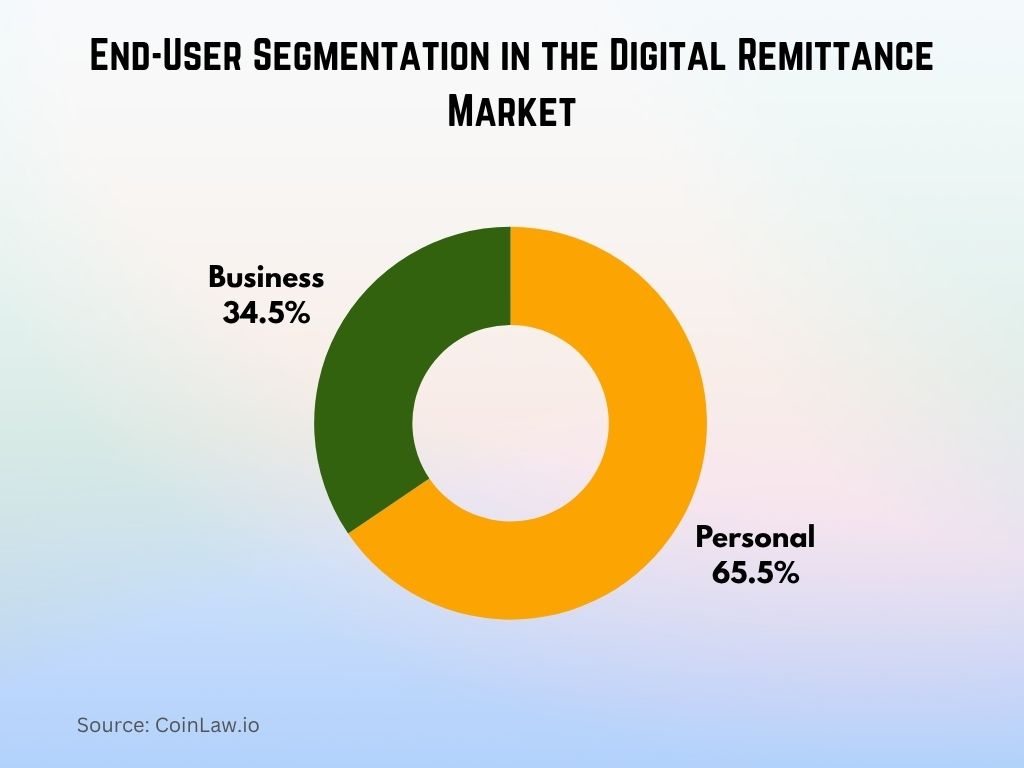
Recent Developments
- Western Union expanded its digital services by launching international money transfer capabilities within the Penny Pinch app, enhancing global remittance options for users in Saint Lucia.
- Ripple continued its collaboration with the Royal Monetary Authority of Bhutan to pilot a central bank digital currency (CBDC), aiming to enhance cross-border payments and financial inclusion in the region.
- Remitly introduced the Circle App, allowing users to send, store, and spend money globally with no fees, providing a seamless experience for international transactions.
- MoneyGram partnered with Mastercard to enhance digital money movement, enabling customers to send funds from U.S.-issued Mastercard cards to 38 receiving markets worldwide.
- PayPal announced a strategic partnership with TerraPay to facilitate real-time fund transfers across the Middle East and Africa, aiming to improve cross-border payment experiences.
- Meta’s WhatsApp Pay received approval to roll out its peer-to-peer payments service to all users in India, expanding its reach in one of the largest remittance corridors.
- Visa and Mastercard continued to strengthen their cross-border payment solutions, with Visa Direct and Mastercard Send facilitating faster and more secure international money transfers.
Conclusion
The digital remittance landscape is poised for even greater transformation. With blockchain, cryptocurrency, and AI-driven technologies reshaping the way money moves across borders, we are witnessing a shift towards faster, cheaper, and more secure remittance solutions. Key players like Wise, Remitly, and Ripple are setting new standards for transparency and efficiency, while regulatory frameworks evolve to meet the challenges of this fast-growing industry. As mobile adoption rises and remittance costs continue to drop, the global remittance market will remain a lifeline for millions of families worldwide, fueling economic growth and financial inclusion across all corners of the globe.
Hover or focus to see the definition of the term.








